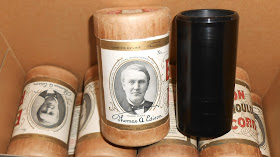 From Peter Pan's Captain Hook to Pirates of the Caribbean's Captain Jack Sparrow, pirates are established and identified though their dress. The credit for the classic pirate costume (coat, boots, sash, and tricorne) could easily be given to Disney, but Disney had a source from which to draw inspiration: Howard Pyle.
From Peter Pan's Captain Hook to Pirates of the Caribbean's Captain Jack Sparrow, pirates are established and identified though their dress. The credit for the classic pirate costume (coat, boots, sash, and tricorne) could easily be given to Disney, but Disney had a source from which to draw inspiration: Howard Pyle.Raised in the Brandywine Valley, Pyle spent his childhood in the picturesque town of Wilmington, Deleware; there, stories such as Grimm's Fairy Tales, The Arabian Nights, Robinson Crusoe, and The Tanglewood Tales fostered Pyle's imagination and creativity. After studying art under F. A. Van der Weilen, Pyle became an author/illustrator for Harpers Magazine. His first illustrated pirate tale, "Buccaneers and Marooners of the Spanish Main," was published here in the August/September 1887 issue. Pyle continued to produce pirate tales, even as he gained recognition for The Merry Adventures of Robin Hood of Great Renown, in Nottinghamshire and his King Arthur tales.
 Howard Pyle spent his summers near the ocean in Rehoboth Beach, Delaware, with his family; many pirates were painted during these summers. Though many of the buccaneering characters of his tales hailed from New York, Virginia, and Delaware, Pyle's pirates stuck to a dress code influenced by sixteenth century sailors and Spanish Gypsies. These clothes would have been impractical for a true pirate, but the task of the buccaneer on the page is not to climb rigging or wash the deck—Pyle's pirates job is to look distinct, exotic, and dangerous.
Howard Pyle spent his summers near the ocean in Rehoboth Beach, Delaware, with his family; many pirates were painted during these summers. Though many of the buccaneering characters of his tales hailed from New York, Virginia, and Delaware, Pyle's pirates stuck to a dress code influenced by sixteenth century sailors and Spanish Gypsies. These clothes would have been impractical for a true pirate, but the task of the buccaneer on the page is not to climb rigging or wash the deck—Pyle's pirates job is to look distinct, exotic, and dangerous.Pyle's pirates became iconic, changing the world's perception of what makes a pirate. Harper & Brothers was able to capitalize on Pyle's pirates' popularity by publishing his pirate tales as a collection in 1921, ten years after his death. Howard Pyle's Book of Pirates is not a complete tribute to "Father of Illustration," but does highlight his genius in creating the modern pirate.
Ask for Illus P993howp
Posted for Laura Vang '15





